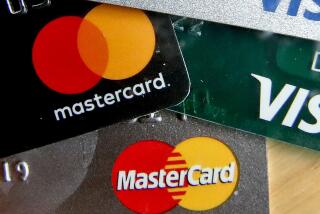Looking for Gold in Plastic : Following others, Culver City will introduce its own credit card in partnership with a local bank.
- Share via
General Motors has a credit card. So does the Sierra Club. So why not Culver City?
With hopes of painlessly raising revenue, the city will put its name on a credit card issued by a local bank and receive a part of the interest on credit card balances that customers carry from month to month.
Culver National Bank has set the interest at 16.95%. The city will receive 0.5% in the first year and 1.5% in following years.
The bank will issue city Visa and MasterCards for a $20 annual fee and gold cards for $50 a year.
Culver City’s card, known in the industry as an affinity card, will not be the first of its kind, although the origin of the municipal credit cards is not clear.
South Orange, N.J., is credited by many with issuing the first city card last December. But officials in Plano, Tex., say they were first with a card in 1993.
The idea is catching on. San Francisco’s Board of Supervisors has approved the issuance of a credit card and a phone card, and the city expects revenues of up to $7 million a year.
New York City might issue a credit card by the end of the year, said Bill Calabrese, president of the village of South Orange. Calabrese is working with New York officials to develop the card.
What is unique about Culver City’s proposal is that the city would earn a percentage of the debt carried by cardholders. Other cities take a percentage of customers’ credit card purchases--usually 1% or, in the case of San Francisco, 3%.
Culver City Councilman Albert Vera, who proposed issuing the city card, said he had not realized it was possible to set the card up so that the city received a percentage of purchases.
“We have to start somewhere,” he said, “and if we have to modify the card later, we can do that.”
*
Affinity cards--already used by some charities--generate revenue with little if any cost to the city or agency.
In Culver City, officials and bank executives declined to say how much revenue they expect to generate from the card.
Some council members doubt that the card will bring in much additional money. Councilman Mike Balkman said: “It’s not going to be a situation where people will say they’ll choose their Culver City card over other ones.”
But Vera is optimistic that the cards will earn enough money to lower city taxes. He is lobbying his council colleagues to earmark any card revenues for that purpose.
Mayor Steve Gourley says the city should deposit the money in its general fund, adding, “I don’t think it’s a good idea to earmark anything for anything.”
The bank will market the card, decorated with a picture of the new City Hall, to its estimated 4,000 customers, most of whom live in Culver City or nearby.
The success of Culver City’s card depends on two things: the civic pride of the city’s residents and the credit card debt they carry.
Bank officials view the card as a way to gain customers and build a stronger relationship with both its customers and the city.
“When Albert [Vera] contacted us a year ago, we weren’t sold on the idea,” said Culver National President John Newhouse.
Bank officials were concerned about issuing any credit cards, whether a city card or not, because of problems with card theft and unpaid bills, he said.
“But then we decided it was a win-win situation. The city could earn money, and maybe we could get more business from it.”
*
In Plano, city officials have been able to funnel about $700 a month to local arts programs from its credit card.
But South Orange has been the true success story. Since the village began marketing its card last year to its 17,000 residents, it has generated about $5,000 a month and expects to earn $100,000 by the end of this year, Calabrese said.
More to Read
Inside the business of entertainment
The Wide Shot brings you news, analysis and insights on everything from streaming wars to production — and what it all means for the future.
You may occasionally receive promotional content from the Los Angeles Times.










